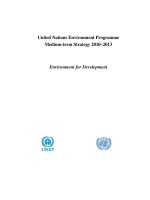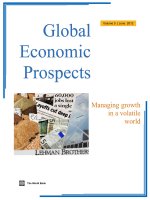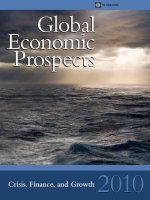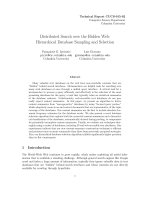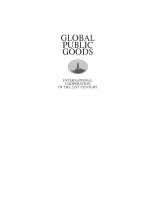Global Economic Prospects Assuring growth over the medium term pot
Bạn đang xem bản rút gọn của tài liệu. Xem và tải ngay bản đầy đủ của tài liệu tại đây (10.71 MB, 178 trang )
Global
Global
Global
Economic
Economic
Economic
Prospects
Prospects
Prospects
Volume 6
Volume 6
Volume 6
| January 2013
| January 2013
| January 2013
The World Bank
Assuring
growth over
the medium term
3
Global Economic Prospects
Assuring growth over the medium term
January 2013
4
© 2013 International Bank for Reconstruction and Development / The World Bank
1818 H Street NW, Washington DC 20433
Telephone: 202-473-1000; Internet: www.worldbank.org
Some rights reserved
1 2 3 4 16 15 14 13
This work is a product of the staff of The World Bank with external contributions. Note that The World Bank does
not necessarily own each component of the content included in the work. The World Bank therefore does not war-
rant that the use of the content contained in the work will not infringe on the rights of third parties. The risk of
claims resulting from such infringement rests solely with you.
The findings, interpretations, and conclusions expressed in this work do not necessarily reflect the views of The
World Bank, its Board of Executive Directors, or the governments they represent. The World Bank does not guar-
antee the accuracy of the data included in this work. The boundaries, colors, denominations, and other information
shown on any map in this work do not imply any judgment on the part of The World Bank concerning the legal
status of any territory or the endorsement or acceptance of such boundaries.
Nothing herein shall constitute or be considered to be a limitation upon or waiver of the privileges and immunities
of The World Bank, all of which are specifically reserved.
Rights and Permissions
This work is available under the Creative Commons Attribution 3.0 Unported license (CC BY 3.0) http://
creativecommons.org/licenses/by/3.0. Under the Creative Commons Attribution license, you are free to copy, dis-
tribute, transmit, and adapt this work, including for commercial purposes, under the following conditions:
Attribution—Please cite the work as follows: The World Bank. 2013. Global Economic Prospects, Volume 6,
January 2013. Washington, DC: World Bank.
Doi: 10.1596/ 978-0-8213-9882-1 License: Creative Commons Attribution CC BY 3.0
Translations—If you create a translation of this work, please add the following disclaimer along with the attribu-
tion: This translation was not created by The World Bank and should not be considered an official World Bank
translation. The World Bank shall not be liable for any content or error in this translation.
All queries on rights and licenses should be addressed to the Office of the Publisher, The World Bank, 1818 H
Street NW, Washington, DC 20433, USA; fax: 202-522-2625; e-mail: .
ISBN (electronic): 978-0-8213-9882-1
DOI: 10.1596/ 978-0-8213-9882-1
Cover photo: Jonathan Guy; Cover design: Roula I. Yazigi
The cutoff date for the data used in the report was January 9, 2013. Dollars are current U.S. dollars
unless otherwise indicated.
5
Acknowledgments
This report is a product of the Prospects Group in the Development Economics Vice Presidency of the World
Bank. Its principal authors were Andrew Burns and Theo Janse van Rensburg.
The project was managed by Andrew Burns, under the direction of Hans Timmer and the guidance of Kaushik
Basu. Several people contributed substantively to the report. The modeling and data team was led by Theo Janse
van Rensburg, assisted by Trung Thanh Bui, Muhammad Adil Islam, Irina Magyer, and Sabah Zeehan Mirza. The
projections, regional write-ups and subject annexes were produced by Dilek Aykut (Finance, Europe & Central
Asia), John Baffes (Commodities), Damir Cosic (Commodities & Latin America & Caribbean), Allen Dennis (Sub
-Saharan Africa and International Trade), Sanket Mohapatra (South Asia, Middle East & North Africa, Industrial
Production and Exchange Rates), Eung Ju Kim (Finance), Cristina Savescu (Latin America & Caribbean, Indus-
trial Production), Theo Janse van Rensburg (Latin America & Caribbean and High-Income Countries) and
Ekaterine Vashakmadze (East Asia & the Pacific and Inflation). Regional projections and annexes were produced
in coordination with country teams, country directors, and the offices of the regional chief economists and PREM
directors. The short-term commodity price forecasts were produced by John Baffes, Damir Ćosić, and Betty Dow.
The remittances forecasts were produced by Gemechu Ayana Aga and Dilip K. Ratha. Simulations were performed
by Irina Magyer and Theo Janse van Rensburg.
The accompanying online publication, Prospects for the Global Economy, was produced by a team comprised of
Sarah Crow, Betty Dow, Muhammad Adil Islam, Vamsee Krishna Kanchi, Sabah Mirza, Katherine Rollins, and
Dana Vorisek, with technical support from David Horowitz, Ugendran Machakkalai, and Malarvishi Veerappan.
Cynthia Case-McMahon, Indira Chand, and Merrell Tuck-Primdahl managed media relations and the dissemina-
tion. Hazel Macadangdang managed the publication process.
Several reviewers offered extensive advice and comments. These included Abdul de Guia Abiad, Ahmad Ahsan,
Jorge Araujo, Merli Baroudi, Deepak Bhattasali, Andrew Beath, Zeljko Bogetic, Oscar Calvo-Gonzalez, Kevin
Carey, Mei Leng Chang, Shubham Chaudhuri, Punam Chuhan-Pole, Tito Cordella, Jose Cuesta, Uri Dadush, Au-
gusto de la Torre, Shantayanan Devarajan, Tatiana Didier, Hinh Truong Dinh, Sebastian Eckardt, Olga Emelyanov,
Pablo Fajnzylber, Manuela V. Ferro, Caroline Freund, Bernard G. Funck, Ejaz Ghani, David Michael Gould,
Guenter Heidenhof, Bert Hofman, Zahid Hussain, Elena Ianchovichina, Satu Kristina Kahkonen, Markus Kitzmul-
ler, Auguste Tano Kouame, David Kuijper, Roumeen Islam, Jeffrey D. Lewis, Connie Luff, Ernesto May, Denis
Medvedev, Juan Carlos Mendoza, Claudia Nassif, Antonio M. Ollero, Kwang Park, Samuel Pienknagura, Miria
Pigato, Mohammad Zia Qureshi, Susan R. Razzaz, Christine M. Richaud, Kaspar Richter, Elliot Riordan, David
Rosenblatt, Sudhir Shetty, Carlos Silva-Jauregui, Yvonne M. Tsikata, Cevdet Unal, Mark Roland Thomas, Axel
van Tortsenberg, Sergei Ulatov, Aristomene Varoudakis, Gallina Vincelette, Ekaterina Vostroknutova, Herman
Jorge Winkler, Soonhwa Yi, Juan F. Zalduendo, and Albert Zeufack.
6
Table of Contents
Main Text 1
Topical Annexes
Financial markets 33
Industrial production. 43
Inflation. 49
Global trade 59
Exchange rates 65
Prospects for commodity markets 75
Regional Annexes
East Asia & the Pacific 91
Europe & Central Asia 103
Latin America & the Caribbean 115
Middle East & North Africa 125
South Asia 139
Sub-Saharan Africa 155
Four years after the onset of the global financial
crisis, the world economy continues to struggle.
Developing economies are still the main driver
of global growth, but their output has slowed
compared with the pre-crisis period. To regain
pre-crisis growth rates, developing countries
must once again emphasize internal productivity
-enhancing policies. While headwinds from
restructuring and fiscal consolidation will persist
in high-income countries, they should become
less intense allowing for a slow acceleration in
growth over the next several years.
Financial market conditions have improved
dramatically since June
The cumulative effect of national- and EU-wide
measures to improve fiscal sustainability, and
the augmentation of measures that the European
Central Bank (ECB) would be willing to take in
defense of the Euro have resulted in a significant
improvement in global financial markets. Unlike
past episodes of reduced tensions, when market
conditions improved only partially, many market
risk indicators have fallen back to levels last
seen in early 2010 – before concerns about Euro
Area fiscal sustainability took the fore.
The decline in financial market tensions has also
been felt in the developing world.
International capital flows to developing
countries, which fell by between 30 and 40
percent in May-June, have reached new highs.
Developing country bond spreads (EMBIG)
have declined by 127 basis points (bps) since
June, and are now 282 bps below their long-
term average levels.
Developing country stock markets have
increased by 12.6 percent since June (10.7
percent for high-income markets)
but the real-side recovery is weak and business-
sector confidence low
While signals from financial markets are
encouraging, those emanating from the real-side
of the global economy are more mixed. Growth
in developing countries accelerated in the third
quarter of 2012, including in major middle-
income countries such as Brazil and China,
where mid-year weakness contributed to the
global slowdown. Early indications for the
fourth quarter point to a continued acceleration
in East Asia & the Pacific, Europe & Central
Asia and South Asia; but slowing in Latin
America & the Caribbean.
Among high-income countries, investment and
industrial activity in the United States show
unusual weakness – seemingly due to
uncertainty over the stance of fiscal policy in the
run up to November‘s elections and the end-of-
2012 fiscal cliff. In Japan, the economy appears
to be contracting – in part because of political
tension with China over the sovereignty of
islands in the region and the expiration of
automobile purchase incentives. Activity in
Europe ceased to contract at alarming rates in
Q3, but the economy appears to have weakened
again in Q4 — perhaps reflecting weak demand
for capital goods from the United States and
Japan.
Prospects are for a modest acceleration of
growth between 2013 and 2015
Overall, the global economic environment
remains fragile and prone to further
disappointment, although the balance of risks is
now less skewed to the downside than it has
been in recent years. Global growth is expected
to come in at a relatively weak 2.3 and 2.4
percent in 2012 and 2013 respectively and
gradually strengthen to 3.1 and 3.3 percent in
2014 and 2015 (table 1).
Global Economic Prospects January 2013:
Assuring growth over the medium term
Overview & main messages
2
Table 1. The global outlook in summary
(percent change from previous year, except interest rates and oil price)
2011 2012 2013e 2014f 2015f
Global conditions
World trade volume (GNFS) 6.2 3.5 6.0 6.7 7.0
Consumer prices
G-7 Countries
1,2
5.3 -0.6 -0.1 0.9 1.0
United States 2.4 2.1 2.4 2.5 2.5
Commodity prices (USD terms)
Non-oil commodities 20.7 -9.5 -2.0 -3.2 -2.8
Oil price (US$ per barrel)
3
104.0 105.0 102.0 102.2 102.1
Oil price (percent change) 31.6 1.0 -2.9 0.2 -0.1
Manufactures unit export value
4
8.9 -1.9 1.9 2.2 1.9
Interest rates
$, 6-month (percent) 0.8 0.5 0.7 1.1 1.4
€, 6-month (percent)
1.6 0.2 0.5 1.2 1.5
International capital flows to developing countries (% of GDP)
Developing countries
Net private and official inflows 4.9 4.1 4.2 4.2 4.2
Net private inflows (equity + debt) 4.7 4.1 4.2 4.2 4.1
East Asia and Pacific 4.9 3.5 3.8 4.1 4.2
Europe and Central Asia 5.7 4.8 5.3 5.2 4.8
Latin America and Caribbean 5.5 5.7 5.2 4.7 4.3
Middle East and N. Africa 1.3 1.1 1.4 1.6 1.9
South Asia 3.5 3.3 3.4 3.5 3.4
Sub-Saharan Africa 5.3 5.0 4.7 4.7 4.9
Real GDP growth
5
World 2.7 2.3 2.4 3.1 3.3
Memo item: World (2005 PPP weights) 3.8 3.0 3.4 3.9 4.1
High income 1.6 1.3 1.3 2.0 2.3
OECD countries 1.5 1.2 1.1 2.0 2.3
Euro Area 1.5 -0.4 -0.1 0.9 1.4
Japan -0.7 1.9 0.8 1.2 1.5
United States 1.8 2.2 1.9 2.8 3.0
Non-OECD countries 5.0 2.9 3.5 3.8 3.8
Developing countries 5.9 5.1 5.5 5.7 5.8
East Asia and Pacific 8.3 7.5 7.9 7.6 7.5
China 9.3 7.9 8.4 8.0 7.9
Indonesia 6.5 6.1 6.3 6.6 6.6
Thailand 0.1 4.7 5.0 4.5 4.5
Europe and Central Asia 5.5 3.0 3.6 4.0 4.3
Russia 4.3 3.5 3.6 3.9 3.8
Turkey 8.5 2.9 4.0 4.5 5.0
Romania 2.5 0.6 1.6 2.2 3.0
Latin America and Caribbean 4.3 3.0 3.5 3.9 3.9
Brazil 2.7 0.9 3.4 4.1 4.0
Mexico 3.9 4.0 3.3 3.6 3.6
Argentina 8.9 2.0 3.4 4.1 4.0
Middle East and N. Africa
6
-2.4 3.8 3.4 3.9 4.3
Egypt
7
1.8 2.2 2.6 3.8 4.7
Iran 1.7 -1.0 0.6 1.6 2.8
Algeria 2.5 3.0 3.4 3.8 4.3
South Asia 7.4 5.4 5.7 6.4 6.7
India
7, 8
6.9 5.1 6.1 6.8 7.0
Pakistan
7
3.0 3.7 3.8 4.0 4.2
Bangladesh
7
6.7 6.3 5.8 6.2 6.5
Sub-Saharan Africa 4.5 4.6 4.9 5.1 5.2
South Africa 3.1 2.4 2.7 3.2 3.3
Nigeria 6.7 6.5 6.6 6.4 6.3
Angola 3.4 8.1 7.2 7.5 7.8
Memorandum items
Developing countries
excluding transition countries 6.5 5.2 5.8 6.0 6.0
excluding China and India 4.5 3.3 4.0 4.3 4.4
7.
8.
Real GDP at market prices. GDP growth rates calculated using real GDP at
factor cost, which are customarily reported in India, can vary significantly from
these growth rates and have historically tended to be higher than market price
GDP growth rates. Growth rates stated on this basis, starting with FY2011-12
are 6.5, 5.4, 6.4, 7.1, and 7.3 percent – see table SAR.2 in the South Asia
regional annex.
In keeping with national practice, data for Bangladesh, Egypt, India, and Pakistan
are reported on a fiscal year basis in table 1.1. Aggregates that depend on
these countries are calculated using data compiled on a calendar year basis.
Source: World Bank.
Notes: PPP = purchasing power parity; e = estimate; f = forecast.
1. Canada, France, Germany, Italy, Japan, the United Kingdom, and the United
States.
2. In local currency, aggregated using 2005 GDP weights.
3. Simple average of Dubai, Brent, and West Texas Intermediate.
4. Unit value index of manufactured exports from major economies, expressed in
USD.
5. Aggregate growth rates calculated using constant 2005 dollars GDP weights.
6. Comparison with the summer 2012 GEP is not included as country coverage
3
At an estimated 5.1 percent, GDP growth in
developing countries during 2012 was among the
slowest in 10 years. Improved financial
conditions, a relaxation of monetary policy, and
somewhat stronger high-income country growth
is projected to gradually raise developing-
country growth to 5.5 percent in 2013, and to 5.7
and 5.8 percent in 2014 and 2015 — roughly in
line with these countries‘ underlying potential.
For high-income countries, fiscal consolidation,
high unemployment and very weak consumer
and business confidence will continue to weigh
on activity in 2013, when GDP is projected once
again to expand a mediocre 1.3 percent. Growth
should, however, begin firming during the
course of 2013, expanding by 2.0 and 2.3
percent in 2014 and 2015.
This modest growth outlook is subject to risks.
Although the likelihood of a serious crisis of
confidence in the Euro Area that would lead
to a bloc-wide freezing up of financial
markets has declined significantly, continued
progress is needed to improve country-level
finances, and enact plans to reinforce pan-
European schemes for a banking union and
sovereign rescue funds. If policy fails to
maintain its reform momentum, some of the
more vulnerable countries in the Euro Area
could find themselves frozen out of capital
markets, provoking a global slowdown that
could potentially subtract 1.1 percent or more
from developing country GDP.
In the United States, solid progress toward
outlining a credible medium-term fiscal
consolidation plan that avoids periodic
episodes of brinksmanship surrounding the
debt ceiling is needed. Policy uncertainty has
already dampened growth. Should
policymakers fail to agree such measures, a
loss of confidence in the currency and an
overall increase in market tensions could
reduce US and global growth by 2.3 and 1.4
percent respectively.
While a progressive decline in China‘s
unusually high investment rate over the
medium– to long-term is not expected to
perturb global growth, there would be
significant domestic and global consequences
if this position were to unwind abruptly.
Impacts for developing commodity exporters
would be especially harsh if commodity
prices fell sharply.
An interruption to global oil supply and a
resurgence in the price of internationally-
traded food commodities remain risks,
especially given low maize stocks. Should
local food prices rise markedly, nutrition and
health outcomes for the very poor could be
hit.
On the upside, a rapid resolution to policy
uncertainty in the United States, a decrease in
tensions in Asia, or an improvement in
European confidence could speed the return
of high-income countries to stronger growth
— with positive effects for developing-
country exports and GDP.
Addressing high unemployment and slack
capacity remain priorities for countries in
developing Europe
FN1
and the Middle-East &
North Africa. However, the majority of
developing countries are operating at or close to
full capacity. For them, additional demand
stimulus could be counter-productive – raising
indebtedness and inflation without significant
payoff in terms of additional growth.
In what is likely to remain a difficult external
environment characterized by slow and
potentially volatile high-income country growth
over the next several years, strong growth in
developing countries is not guaranteed. To keep
growing rapidly, developing countries will need
to maintain the reform momentum that
underpinned the acceleration of growth during
the 1990s and 2000s. In the absence of
additional efforts to raise productivity through
structural reforms, investment in human capital,
and improved governance and investment
conditions, developing country growth may well
slow.
Moreover, given the still uncertain global
environment, many developing countries would
be well advised to gradually restore depleted
fiscal and monetary buffers, so as to ensure that
their economies can respond as resiliently as
they did during the 2008/09 crisis should a
further significant external shock arise.
Global Economic Prospects January 2013 Main Text

